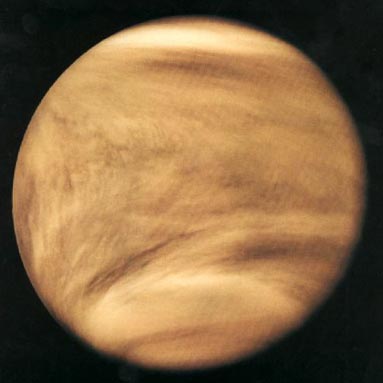[/caption]
When you look up into the sky, if you are lucky, you see shining stars on a field of blue-black. Not all of these objects are stars though. Venus, which can be seen with the unaided eye from Earth, is the brightest planet in our Solar System. Venus was given the nickname evening star and morning star because of its bright, consistent presence. It is often called Earth’s twin because it is similar in shape and size to our own planet. The only objects brighter than Venus are the Moon and the Sun. Sirius, the brightest star that can be seen in the sky, is much dimmer than Venus is. People have known that Venus existed for centuries. The planet was named after the Roman goddess of love and this shining planet has long been associated with femininity.
A planet’s brightness is determined by how much light is reflected by the planet. The term albedo refers to the balance between how much light is absorbed and how much light is reflected by the planet. As the brightest planet, Venus has a very high albedo. Seventy percent of the light that hits Venus is reflected back into space. Why does Venus have such a high albedo though? There are droplets of sulfuric acid and acidic crystals in the atmosphere of Venus. The smooth surfaces of these droplets of sulfuric acid and crystals reflect light very well, which is one reason why Venus is so bright. There is a lot more to this planet than its shimmering appearance though.
The same atmosphere that causes Venus to shine like a beacon also prevents us from getting a look at the planet’s surface. Astronomers did not know what the planet looked like until probes checked out the surface in the last few decades. Because the surface of Venus could not be seen, scientists and writers imagined that it was a tropical, lush landscape. That was not the case though. In addition to hiding the surface and reflecting light, Venus’ atmosphere traps heat from the Sun, turning the planet into a raging furnace. Reaching temperatures of over 460°C, Venus is the hottest planet in the Solar System. Its landscape is similar to that of Mercury and the Moon – rocky, barren terrain with no sign of life. Venus has long enchanted viewers with its beauty and shining presence. Try looking for this planet in the sky; you may find yourself captivated by this shining beauty like many before you.
Universe Today has many articles on Venus including the atmosphere of Venus and how to find Venus in the sky.
For more information check out these articles from NASA on an overview of Venus and from Nine Planets on the brightest planet.
Astronomy Cast has an episode on Venus you should take a look at.


